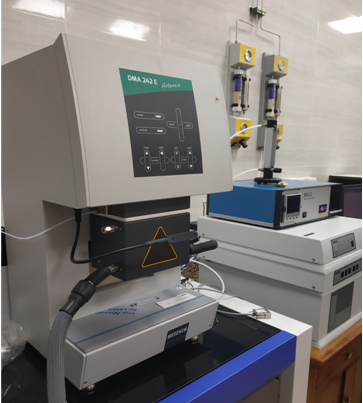| |
|
Dynamic Mechanical Analyzer (DMA)
 Kindly download Material Safety Data sheet and submit the hardcopy of filled sheet along with your sample Kindly download Material Safety Data sheet and submit the hardcopy of filled sheet along with your sample
|
|
| Make: |
Netzsch |
| Model: |
DMA 242 E Artemis |
| Specifications: |
|
|
| Temperature Range: |
-170 to 600°C |
| Heating Rates: |
0.01 to 20°C |
| Frequency range: |
0.01 to 100 Hz |
| High Force Range: |
24N (12N static and 12N dynamic) |
| Amplitude range: |
±0.1 upto 240 µm |
| Modulus range: |
10-3 to 106 MPa (depends on deformation mode) |
| Static deformation: |
20 mm |
| Maximum Deformation amplitude: |
+240 µm |
| Available Geometries: |
 Three-point bending (40 mm) Three-point bending (40 mm)
 Single and Dual Cantilever (2 x 16 mm) Single and Dual Cantilever (2 x 16 mm)
 Shearing (Sandwich geometry) Shearing (Sandwich geometry)
 Compression/ penetration (Ø 15 mm) Compression/ penetration (Ø 15 mm)
 Tension (15 mm) Tension (15 mm)
|
| Atmosphere: |
Nitrogen and Air |
| Cooling Devices: |
Liquid Nitrogen and Air Intra Cooler |
| Accessories: |
Immersion Bath, Humidity Generator |
|
 |
Dynamic Mechanical Analyzer (DMA) measures the mechanical properties of a material as a function of time, temperature, and frequency under an oscillatory load. The DMA works by applying an oscillatory force to the sample at a specific frequency and measuring the resulting deformation. The amplitude and phase of the applied force and the resulting deformation are recorded, allowing for the calculation of various mechanical properties.
By varying the frequency, temperature, and applied stress or strain, the DMA can provide information about the material's viscoelastic properties. Viscoelastic properties refer to their ability to exhibit both elastic and viscous responses when subjected to deformation. The instrument can measure properties like storage modulus (elastic response), loss modulus (viscous response), glass transition temperature, and other mechanical properties.
|
 Viscoelastic properties such as: Viscoelastic properties such as:
- Storage modulus: E', G' (purely elastic component).
- Loss modulus: E", G" (purely viscous component).
- Loss tangent: tan δ (E"/E’), and their dependence on temperature/ frequency.
 Damping characteristics and viscoelastic behaviour. Damping characteristics and viscoelastic behaviour.
 Polymer structure and morphology. Polymer structure and morphology.
 Glass transition temperature Tg. Glass transition temperature Tg.
 Primary & secondary relaxation behaviour. Primary & secondary relaxation behaviour.
 Crystallization processes. Crystallization processes.
 Influence of fillers in polymers, etc. Influence of fillers in polymers, etc.
|
Phone: 022-2159-6857/6889/6866
Email: nmr600@iitb.ac.in
|
|
Required Sample Dimensions
|
| Mode | Length/diameter | Width | Thickness/Height |
| 1. | Tension | 18-20 mm | 4-6 mm | < 6 mm |
| 2. | Single Cantilever Bending | 30-40 mm | < 12 mm | < 5 mm |
| 3. | Double Cantilever Bending | 55-60 mm | < 12 mm | < 5 mm |
| 4. | 3-point bending | 55-60 mm | < 12 mm | < 8 mm |
| 5. | Shear mode with flat surface | 15 mm | 15 mm | < 6 mm |
| 6. | Compression and penetration | 15 mm | --- | < 8 mm |
|
|
Charges excluding 18% GST
|
| Internal (IITB) | University | National Lab/R&D's | Industry |
Heating Program:
Temp. Range @ 2 °C/min | Per sample
(per hour) | Per sample
(per hour) | Per sample
(per hour) | Per sample
(per hour) |
| Positive Temp. (above RT upto 600 °C) | 400/- | 944/- | 2360/- | 4720/- |
| Negative Temp ( below RT upto -150 °C ) | 600/- | 1416/- | 3540/- | 7080/- |
|
|
